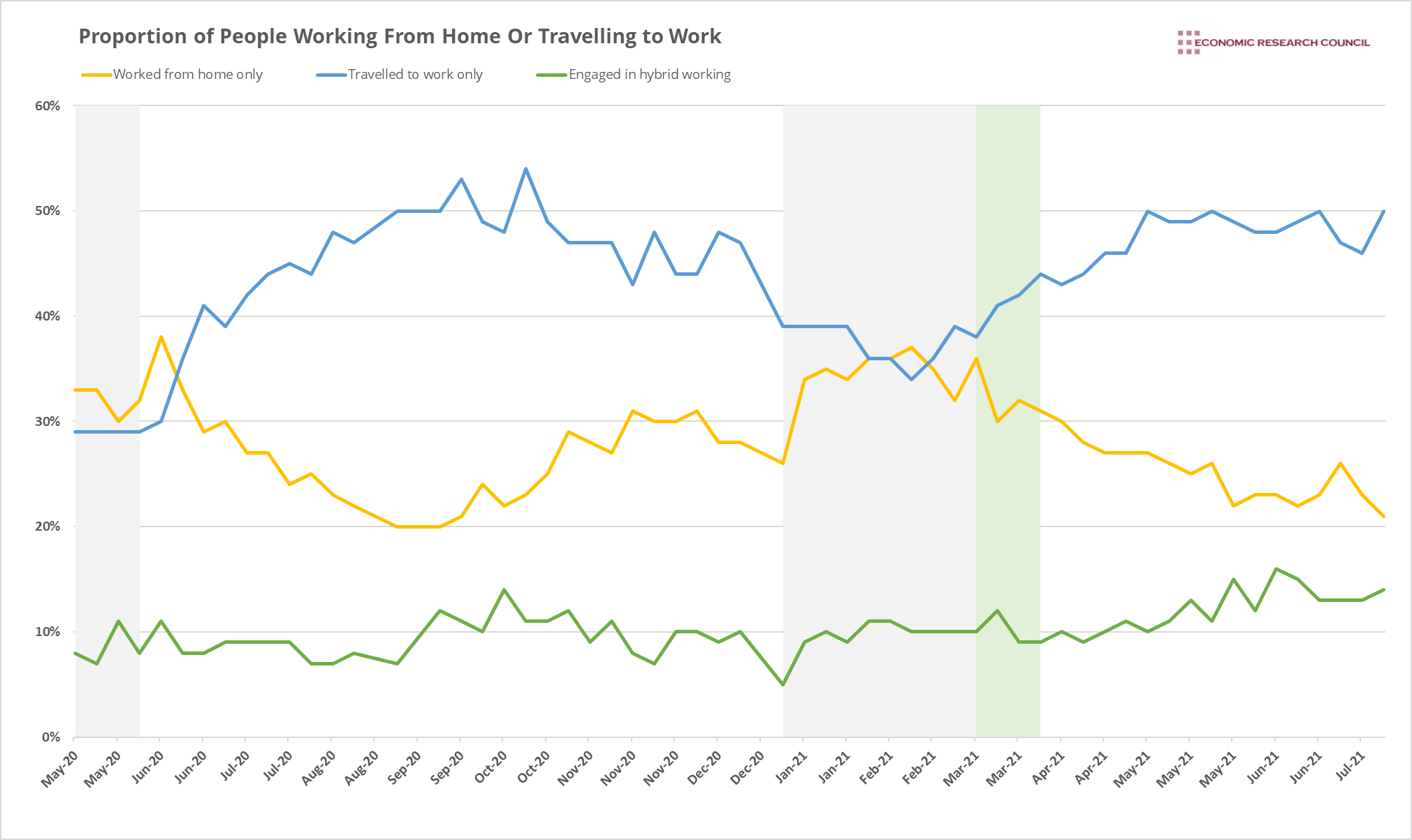Summary
The proportion of people working exclusively from home has been correlated with school closures and lockdown restrictions. Until recently, hybrid working has not shown a similar trend. The experience of working from home is now starting to alter expectations of hybrid working. This certainly provides economic challenges, though it can also bring about opportunities.
What does the chart show?
The chart utilises Office for National Statistics data that displays the proportion of people that have worked from home or travelled to work between May 2020 and July 2021. The blue line shows the proportion of people that have only travelled to work, the yellow line shows those who have only worked from home, and the green line shows those who have combined travelling to work with working from home. The grey bars represent periods where schools in England were ordered to close by the government. The green bar represents the first phase of the easing of restrictions that occurred after the third lockdown.
Why is the chart interesting?
The chart shows that reductions in the number of people working from home are strongly correlated with the reopening of schools. The June 2020 reopening of schools seems to have significantly encouraged parents to return to their place of work. In a similar vein, the extended school closures of January 2021 encouraged working from home. Schools reopening in March 2021, as well as the lifting of some restrictions, further encouraged people to return to their place of work.
More interestingly, the chart displays no clear trend in hybrid working patterns until the third lockdown restrictions were eased, which presents interesting implications. It may have been assumed that as schools close, more people would decide to engage in hybrid working, but this has not been displayed in the data (a small increase occurs in January 2021, but not beyond levels seen in the previous academic term). One reason for this is that people who fully work from home or an office are likely to do so when that is the only option available, as expressed in the paragraph above. There is likely to be more of an element of choice available with hybrid working. The fact that the proportion of people choosing hybrid working displays no clear trend, up until April 2021 suggests personal choice has not been an important factor when determining where people work. Instead, government policy has guided this. A recent ONS Business Insights and Conditions survey stated that 85% of people currently working from home expect to share their time between working remotely and in an office. However, around 10% of workers managed to achieve this through most of the period being analysed. A key departure occurred as the restrictions of the third lockdown were eased. Since April 2021, more people have managed to combine remote working with going into their usual place of work, which suggests that the experiences of working from home are beginning to tangibly alter the way that the population interacts with their workplace.
Employers are also responding to these developments. 24% of businesses suggested they would increase their use of remote working in the future, with the information and communication sector leading the charge. Instead of simply answering workers’ requests, businesses see clear benefits of remote working, in terms of improved staff wellbeing, reduced overheads and increased productivity, although these benefits are not shared across all industries.
The job market has reflected this shift. Research by Adzuna, a leading online job search engine, has indicated that job adverts including the term ‘homeworking’ increased threefold in May 2021 compared to February 2020. Despite this, these only accounted for 8% of total job adverts.
A degree of change in the location in which people conduct their work seems likely, whether small or large. A crucial question to answer here involves how the wider economy responds to it. Images of empty high streets, coffee chains being forced to adapt their business models, and reductions in income for commercial landlords have all displayed some of the negative consequences of working from home. City centres will surely be the losers in this process, but there is scope for some economic activity to be transferred to more residential areas as people visit local workspaces, patronise independent cafés for lunch and utilise their local post offices. As we begin to escape the shadows of successive lockdowns, how the workforce responds will be crucial in shaping the structure of the future economy.
By David Dike


